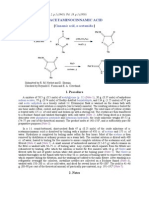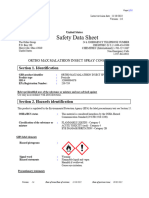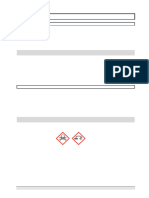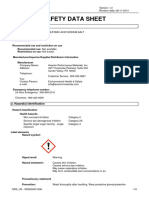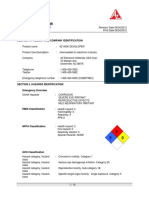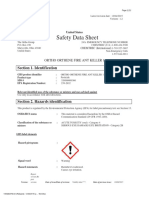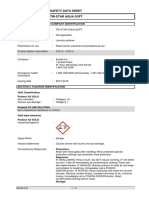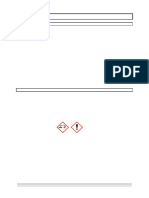2410 6 Goof Off Professional Strength EN
2410 6 Goof Off Professional Strength EN
Uploaded by
atamxqexekrsrnochiCopyright:
Available Formats
2410 6 Goof Off Professional Strength EN
2410 6 Goof Off Professional Strength EN
Uploaded by
atamxqexekrsrnochiOriginal Title
Copyright
Available Formats
Share this document
Did you find this document useful?
Is this content inappropriate?
Copyright:
Available Formats
2410 6 Goof Off Professional Strength EN
2410 6 Goof Off Professional Strength EN
Uploaded by
atamxqexekrsrnochiCopyright:
Available Formats
SAFETY DATA SHEET Page: 1 of 8
Goof Off Professional Strength Revision: 02/18/2020
Supersedes Revision: 11/04/2019
This SDS complies with the Canadian Hazardous Products Regulations of 2015.
1. PRODUCT AND COMPANY IDENTIFICATION
Product Name: Goof Off Professional Strength
Company Name: W. M. Barr Phone Number:
2105 Channel Avenue (901)775-0100
Memphis, TN 38113
Web site address: www.wmbarr.com
Emergency Contact: 3E 24 Hour Emergency Contact (800)451-8346
Information: W.M. Barr Customer Service (800)398-3892
Product Category: General Purpose Adhesive Remover
Intended Use: Multi-Purpose Remover for rar, ink, paint, adhesive, etc.
Product Code: FG612, FG631, FG653, FG654, FG654LWS, FG655AM, FG655B, FG655BUL,
FG655B36HDWS, FG657, FG661, FG690, FG6616, FG661CAN
2. HAZARDS IDENTIFICATION
Flammable Liquids, Category 2
Acute Toxicity: Inhalation, Category 4
Carcinogenicity, Category 2
Skin Corrosion/Irritation, Category 2
Serious Eye Damage/Eye Irritation, Category 2
Specific Target Organ Toxicity (single exposure), Category 1
Specific Target Organ Toxicity (repeated exposure), Category 2
GHS Signal Word: Danger
GHS Hazard Phrases: Highly flammable liquid and vapor.
Causes skin irritation.
Causes serious eye irritation.
Harmful if inhaled.
Suspected of causing cancer .
Causes damage to organs
May cause damage to - Auditory system. through prolonged or repeated exposure.
GHS Precautionary Phrases: Obtain special instructions before use.
Do not handle until all safety precautions have been read and understood.
Keep away from heat/sparks/open flames/hot surfaces. - No smoking.
Keep container tightly closed.
Ground/bond container and receiving equipment.
Use explosion-proof electrical/ventilating/lighting/.../ equipment.
Use only non-sparking tools.
Take precautionary measures against static discharge.
Do not breathe fumegas/mist/vapors/spray.
Wash hands thoroughly after handling.
Do not eat, drink or smoke when using this product.
Use only outdoors or in a well-ventilated area.
Wear protective gloves/protective clothing/eye protection/face protection.
GHS Response Phrases: IF ON SKIN: Wash with plenty of soap and water.
IF ON SKIN (or hair): Remove/take off immediately all contaminated clothing. Rinse skin
with water/shower.
Licensed to W.M. Barr and Company Multi-region format
SAFETY DATA SHEET Page: 2 of 8
Goof Off Professional Strength Revision: 02/18/2020
Supersedes Revision: 11/04/2019
IF INHALED: Remove victim to fresh air and keep at rest in a position comfortable for
breathing.
IF IN EYES: Rinse cautiously with water for several minutes. Remove contact lenses, if
present and easy to do. Continue rinsing.
If exposed of concerned: Call a POISON CENTER/Doctor/...
Get medical advice/attention.
Call a POISON CENTER or doctor/physician if you feel unwell.
Get medical attention/advice if you feel unwell.
Specific treatment see label.
If skin irritation occurs, get medical advice/attention.
If eye irritation persists, get medical advice/attention.
Take off contaminated clothing and wash it before reuse.
In case of fire, use dry chemical powder to extinguish.
GHS Storage and Disposal Store in cool/well-ventilated place.
Phrases: Store locked up.
Dispose of contents/container according to local, state and federal regulations.
OSHA Regulatory Status: This material is classified as hazardous under OSHA regulations.
Potential Health Effects **See above.
(Acute and Chronic):
3. COMPOSITION/INFORMATION ON INGREDIENTS
CAS # Hazardous Components (Chemical Name) Concentration
67-64-1 Acetone {2-Propanone} 60.0 -80.0 %
1330-20-7 Xylene (mixed isomers) {Benzene, dimethyl-} 7.0 -13.0 %
100-41-4 Ethylbenzene {Ethylbenzol; Phenylethane} 1.0 -5.0 %
67-56-1 Methanol {Methyl alcohol; Carbinol; Wood 1.0 -5.0 %
alcohol}
110-91-8 Morpholine {Diethylene imidoxide} 0.1 -1.0 %
Additional Chemical Specific percentage of composition is being withheld as a trade secret.
Information
4. FIRST AID MEASURES
Emergency and First Aid Skin:
Procedures: IF ON CLOTHING: Rinse immediately contaminated clothing and skin with plenty of
water before removing clothes.
Eyes:
In case of contact with eyes, flush with copious amounts of water for at least 15 minutes.
Inhalation: If inhaled, remove to fresh air. If not breathing, give artificial respiration. If
breathing is difficult, give oxygen.
Get medical attention immediately.
Ingestion: If swallowed, do not induce vomiting unless directed to do so by medical
personnel. Get medical attention immediately. Never give anything by mouth to an
unconscious person.
Note to Physician: Treat symptomatically and supportively.
Licensed to W.M. Barr and Company Multi-region format
SAFETY DATA SHEET Page: 3 of 8
Goof Off Professional Strength Revision: 02/18/2020
Supersedes Revision: 11/04/2019
5. FIRE FIGHTING MEASURES
NFPA Class IB
Flash Pt: -17.2 C (1.00 F) Method Used: Setaflash Closed Cup (Rapid Setaflash)
Explosive Limits: LEL: N.D. UEL: N.D.
Autoignition Pt: N.D.
Suitable Extinguishing Media: Use water spray, dry chemical, carbon dioxide, or appropriate foam.
Unsuitable Extinguishing **None known.
Media:
Fire Fighting Instructions: Wear self contained breathing apparatus for fire fighting if necessary.
Flammable Properties and Vapor may travel considerable distance to source of ignition and flash back.
Hazards:
Hazardous Combustion Carbon monoxide, Carbon dioxide.
Products:
6. ACCIDENTAL RELEASE MEASURES
Steps To Be Taken In Case Isolate hazard area. Keep unnecessary and unprotected personnel from entering.
Material Is Released Or
Spilled: Stay upwind.
ELIMINATE all ignition sources (no smoking, flares, sparks or flames in immediate area).
Use non-sparking tools.
Take up with sand or other non-combustible absorbent material and place into containers
for later disposal.
Dike far ahead of spill for later disposal.
Avoid runoff into storm sewers and ditches which lead to waterways.
7. HANDLING AND STORAGE
Precautions To Be Taken in Do not reuse this container.
Handling:
Read carefully and follow all instructions.
Do not use this product near any source of heat or open flame, furnace areas, pilot lights,
stoves, etc.
Do not spread this product over large surface areas because fire and health safety risks
will increase dramatically.
Precautions To Be Taken in Keep container tightly closed when not in use. Store in a cool, dry place. Do not store
Storing: near flames or at elevated temperatures.
Other Precautions: Keep away from heat, sparks, and open flame.
8. EXPOSURE CONTROLS/PERSONAL PROTECTION
Licensed to W.M. Barr and Company Multi-region format
SAFETY DATA SHEET Page: 4 of 8
Goof Off Professional Strength Revision: 02/18/2020
Supersedes Revision: 11/04/2019
CAS # Chemical Name Jurisdiction Recommended Exposure Limits Notations
67-64-1 Acetone {2-Propanone} ACGIH TLV TLV: 500 ppm
STEL: 750 ppm
OSHA PELs PEL: 1000 ppm
1330-20-7 Xylene (mixed isomers) ACGIH TLV TLV: 100 ppm
{Benzene, dimethyl-} STEL: 150 ppm
OSHA PELs PEL: 100 ppm
100-41-4 Ethylbenzene ACGIH TLV TLV: 100 ppm
{Ethylbenzol; Phenylethane} STEL: 125 ppm
OSHA PELs PEL: 100 ppm
67-56-1 Methanol {Methyl alcohol; ACGIH TLV TLV: 200 ppm
Carbinol; Wood alcohol} STEL: 250 ppm
OSHA PELs PEL: 200 ppm
110-91-8 Morpholine {Diethylene ACGIH TLV TLV: 20 ppm
imidoxide}
OSHA PELs PEL: 20 ppm
Respiratory Equipment Use respirators and components tested and approved under appropriate government
(Specify Type): standards such as NIOSH (US) or CEN (EU).
Eye Protection: Use equipment for eye protection tested and approved under appropriate government
standards such as NIOSH (US) or EN 166(EU).
Protective Gloves: Wear appropriate gloves to prevent skin exposure.
Other Protective Clothing: Wear appropriate protective clothing to prevent skin exposure.
Engineering Controls Use only with adequate ventilation to prevent buildup of vapors. Do not use in areas
(Ventilation etc.): where vapors can accumulate and concentrate, such as basements, bathrooms or small
enclosed areas. Whenever possible, use outdoors in an open air area. If using indoors
open all windows and doors and maintain a cross ventilation of moving fresh air across
the work area. If strong odor is noticed or you experience slight dizziness, headache,
nausea or eye-watering -- STOP -- ventilation is inadequate. Leave area immediately
and move to fresh air.
Work/Hygienic/Maintenance Wash thoroughly after handling.
Practices:
9. PHYSICAL AND CHEMICAL PROPERTIES
Physical States: [ ] Gas [ X ] Liquid [ ] Solid
Appearance and Odor: solvent odor. Odor threshold not determined.
pH: N.D.
Melting Point: N.D.
Boiling Point: 37.7 C (99.90 F)
Flash Pt: -17.2 C (1.00 F) Method Used: Setaflash Closed Cup (Rapid Setaflash)
Evaporation Rate: >1
Flammability (solid, gas): No data available.
Explosive Limits: LEL: N.D. UEL: N.D.
Vapor Pressure (vs. Air or N.D.
mm Hg):
Vapor Density (vs. Air = 1): N.D.
Licensed to W.M. Barr and Company Multi-region format
SAFETY DATA SHEET Page: 5 of 8
Goof Off Professional Strength Revision: 02/18/2020
Supersedes Revision: 11/04/2019
Specific Gravity (Water = 1): 0.8200 - 0.8248
Density: 6.84 - 6.88 LB/GL
Solubility in Water: No data.
Solubility Notes: Partial or Limited Solublity.
Saturated Vapor N.D.
Concentration:
Octanol/Water Partition N.D.
Coefficient:
Percent Volatile: 100.0 % by weight.
VOC / Volume: 20.0000 % WT
Autoignition Pt: N.D.
Decomposition Temperature: N.D.
Viscosity: < 5 cps
Additional Physical VOC (g/L): 162.32 g/L max.
Information
ND = Not Determined.
10. STABILITY AND REACTIVITY
Stability: Unstable [ ] Stable [ X ]
Conditions To Avoid - No data available.
Instability:
Incompatibility - Materials To Strong oxidizing agents.
Avoid:
Hazardous Decomposition or Carbon monoxide, Carbon dioxide.
Byproducts:
Possibility of Hazardous Will occur [ ] Will not occur [ X ]
Reactions:
Conditions To Avoid - **None known.
Hazardous Reactions:
11. TOXICOLOGICAL INFORMATION
Toxicological Information: This product has not been tested as a whole. Refer to section 2 for health effects.
CAS# 67-64-1:
Standard Draize Test, Eyes, Species: Rabbit, 20.00 MG, Severe.
Result:
Behavioral: Change in motor activity (specific assay).
Behavioral: Alteration of classical conditioning.
- American Journal of Ophthalmology., Ophthalmic Pub. Co., 435 N. Michigan Ave., Suite
1415, Chicago, IL 60611, Vol/p/yr: 29,1363, 1946
CAS# 1330-20-7:
Acute toxicity, LC50, Inhalation, Rat, 5000. PPM, 4 H.
Result:
Behavioral: Muscle contraction or spasticity.
Lungs, Thorax, or Respiration:Other changes.
- Raw Material Data Handbook, Vol.1: Organic Solvents, 1974., National Assoc. of
Printing Ink Research Institute, Francis McDonald Sinclair Memorial Labor, Lehigh Univ.,
Licensed to W.M. Barr and Company Multi-region format
SAFETY DATA SHEET Page: 6 of 8
Goof Off Professional Strength Revision: 02/18/2020
Supersedes Revision: 11/04/2019
Bethlehem, PA 18015, Vol/p/yr: 1,123, 1974
Standard Draize Test, Eyes, Species: Rabbit, 5.000 MG, 24 H, Severe.
Result:
Behavioral: General anesthetic.
Behavioral: Somnolence (general depressed activity).
Behavioral: Irritability.
- "Sbornik Vysledku Toxixologickeho Vysetreni Latek A Pripravku," , Institut Pro Vychovu
Vedoucicn P, Marhold, J.V., Institut Pro Vychovu Vedoucicn, Pracovniku Chemickeho,
Prumyclu Praha Czechoslovakia, Vol/p/yr: -,24, 1972
CAS# 100-41-4:
Tumorigenic Effects:, TCLo, Inhalation, Rat, 750.0 ppm.
Result:
Tumorigenic: Carcinogenic by RTECS criteria.
Kidney, Ureter, Bladder: Tumors.
Standard Draize Test, Eyes, Species: Rabbit, 500.0 MG, Severe.
Result:
Effects on Fertility: Post-implantation mortality (e.g., dead and/or resorbed implants per
total number of implants).
Effects on Fertility: Litter size (e.g.; # fetuses per litter; measured before birth).
Effects on Embryo or Fetus: Fetotoxicity (except death, e.g., stunted fetus).
- American Journal of Ophthalmology., Ophthalmic Pub. Co., 435 N. Michigan Ave., Suite
1415, Chicago, IL 60611, Vol/p/yr: 29,1363, 1946
Carcinogenicity/Other ACGIH A3 - Confirmed Animal Carcinogen with Unknown Relevance to Humans.
Information: ACGIH A4 - Not Classifiable as a Human Carcinogen.
IARC 2B - Possibly Carcinogenic to Humans.
IARC 3: Not Classifiable as to Carcinogenicity in Humans.
CAS # Hazardous Components (Chemical Name) NTP IARC ACGIH OSHA
67-64-1 Acetone {2-Propanone} n.a. n.a. A4 n.a.
1330-20-7 Xylene (mixed isomers) {Benzene, dimethyl-} n.a. 3 A4 n.a.
100-41-4 Ethylbenzene {Ethylbenzol; Phenylethane} n.a. 2B A3 n.a.
67-56-1 Methanol {Methyl alcohol; Carbinol; Wood alcohol} n.a. n.a. n.a. n.a.
110-91-8 Morpholine {Diethylene imidoxide} n.a. 3 A4 n.a.
12. ECOLOGICAL INFORMATION
General Ecological This product has not been tested as a whole.
Information:
Licensed to W.M. Barr and Company Multi-region format
SAFETY DATA SHEET Page: 7 of 8
Goof Off Professional Strength Revision: 02/18/2020
Supersedes Revision: 11/04/2019
13. DISPOSAL CONSIDERATIONS
Waste Disposal Method: Dispose in accordance with applicable local, state, and federal regulations.
14. TRANSPORT INFORMATION
LAND TRANSPORT (US DOT):
DOT Proper Shipping Name: Paint related material.
DOT Hazard Class: 3 FLAMMABLE LIQUID
UN/NA Number: UN1263 Packing Group: II
LAND TRANSPORT (Canadian TDG):
TDG Shipping Name: Paint related material.
UN Number: 1263 Packing Group: II
Hazard Class: 3 - FLAMMABLE LIQUID TDG Classification:
Additional Transport The shipper / supplier may be able to apply one of the following exceptions if allowed
Information: under 49 CFR Regulations: Combustible Liquid, Consumer Commodity, Limited
Quantity, Viscous Liquid, Does Not Sustain Combustion, or others, as allowed under 49
CFR Hazmat Regulations. Please consult 49 CFR Subchapter C to ensure that
subsequent shipments comply with these exceptions.
15. REGULATORY INFORMATION
EPA SARA (Superfund Amendments and Reauthorization Act of 1986) Lists
CAS # Hazardous Components (Chemical Name) S. 302 (EHS) S. 304 RQ S. 313 (TRI)
67-64-1 Acetone {2-Propanone} No Yes 5000 LB No
1330-20-7 Xylene (mixed isomers) {Benzene, dimethyl-} No Yes 100 LB Yes
100-41-4 Ethylbenzene {Ethylbenzol; Phenylethane} No Yes 1000 LB Yes
67-56-1 Methanol {Methyl alcohol; Carbinol; Wood No Yes 5000 LB Yes
alcohol}
110-91-8 Morpholine {Diethylene imidoxide} No No No
CAS # Hazardous Components (Chemical Name) Canadian NPRI Canadian Toxic Canadian DSL
67-64-1 Acetone {2-Propanone} No No Yes
1330-20-7 Xylene (mixed isomers) {Benzene, dimethyl-} Yes: Part 5 Yes
100-41-4 Ethylbenzene {Ethylbenzol; Phenylethane} Yes: Part 1A No Yes
67-56-1 Methanol {Methyl alcohol; Carbinol; Wood Yes: Part 5 Yes
alcohol}
110-91-8 Morpholine {Diethylene imidoxide} No No Yes
CAS # Hazardous Components (Chemical Name) Other US EPA or State Lists
67-64-1 Acetone {2-Propanone} TSCA: Inventory
1330-20-7 Xylene (mixed isomers) {Benzene, dimethyl-} CAA HAP,ODC: HAP: VHAP
CWA NPDES
TSCA: Inventory
100-41-4 Ethylbenzene {Ethylbenzol; Phenylethane} CAA HAP,ODC: HAP: VHAP
CWA NPDES
TSCA: Inventory
CA PROP.65: Yes: Canc.
67-56-1 Methanol {Methyl alcohol; Carbinol; Wood CAA HAP,ODC: HAP: VHAP
alcohol} TSCA: Inventory
CA PROP.65: Yes: RDTox.
Licensed to W.M. Barr and Company Multi-region format
SAFETY DATA SHEET Page: 8 of 8
Goof Off Professional Strength Revision: 02/18/2020
Supersedes Revision: 11/04/2019
110-91-8 Morpholine {Diethylene imidoxide} TSCA: Inventory
Additional Regulatory This product is regulated by the United States Consumer Product Safety Commission
Information and is subject to certain labeling requirements under the Federal Hazardous Substances
Act. These requirements differ from the classification criteria and hazard information
required for safety data sheets (SDS). The product label also includes other important
information, including directions for use, and should always be read in its entirety prior to
using the product.
16. OTHER INFORMATION
Revision Date: 02/18/2020
Preparer Name: W.M. Barr EHS Dept (901)775-0100
Additional Information About No data available.
This Product:
Company Policy or The information contained herein is presented in good faith and believed to be accurate
Disclaimer: as of the effective date shown above. This information is furnished without warranty of
any kind. Employers should use this information only as a supplement to other
information gathered by them and must make independent determination of suitability
and completeness of information from all sources to assure proper use of these materials
and the safety and health of employees. Any use of this data and information must be
determined by the user to be in accordance with applicable federal, state and local laws
and regulations.
Licensed to W.M. Barr and Company Multi-region format
You might also like
- Organic Syntheses Collective Volume 2Document813 pagesOrganic Syntheses Collective Volume 2caltexas88% (8)
- Evonik Ancamine 1856 - SDSDocument13 pagesEvonik Ancamine 1856 - SDStrường phạmNo ratings yet
- SDS - Ecolab Ultra Klene DetergentDocument10 pagesSDS - Ecolab Ultra Klene DetergentNdega Ya ChumaNo ratings yet
- Pocket Identification Wizard PDFDocument32 pagesPocket Identification Wizard PDFMalik Naqash Nazar ChohanNo ratings yet
- LL2359 J Jasco Green Denatured Alcohol ENDocument8 pagesLL2359 J Jasco Green Denatured Alcohol ENFloyd PriceNo ratings yet
- Klean Strip Brush CleanerDocument9 pagesKlean Strip Brush CleanerMariajosé Cabrera MuñozNo ratings yet
- DPG-SDS Kemai-InglesDocument7 pagesDPG-SDS Kemai-InglesimportadorasernamaciaNo ratings yet
- DMFDocument11 pagesDMFKeerthana SNo ratings yet
- Safety Data Sheet Mikro Quat: Section 1. Product and Company IdentificationDocument11 pagesSafety Data Sheet Mikro Quat: Section 1. Product and Company IdentificationpusicantonijeNo ratings yet
- JP K113,1113KDocument6 pagesJP K113,1113KCalidad Mr Paleta PerúNo ratings yet
- 8084 Resin SdsDocument18 pages8084 Resin SdsBen Abdallah BecemNo ratings yet
- Phosphoric Acid MSDSDocument11 pagesPhosphoric Acid MSDSKeily VilcarromeroNo ratings yet
- 0A24DDA67E7A1EDD98A0C3C576D7EEC4Document11 pages0A24DDA67E7A1EDD98A0C3C576D7EEC4vaishalitNo ratings yet
- Us z8 923200 Daily Disinfectant CleanerDocument12 pagesUs z8 923200 Daily Disinfectant Cleaneragustiawn.sumitanceNo ratings yet
- Acetone MsdsDocument16 pagesAcetone MsdsProssy ArksNo ratings yet
- HOROLITH - 617 - 62 - English SDSDocument10 pagesHOROLITH - 617 - 62 - English SDStaherbatubaraNo ratings yet
- Safety Data Sheet: 1. IdentificationDocument10 pagesSafety Data Sheet: 1. Identificationdian iraNo ratings yet
- Piper 89500 800 Dinitrol Av8 S B S 962 977Document10 pagesPiper 89500 800 Dinitrol Av8 S B S 962 977Colin HessionNo ratings yet
- Chockfast Orange Hardener SDS Canada EU EnglishDocument7 pagesChockfast Orange Hardener SDS Canada EU EnglishfebriNo ratings yet
- Sulfuric Acid NitrateDocument10 pagesSulfuric Acid NitrateAliNo ratings yet
- Gramoxone SL 2.0 Herbicide SDSDocument9 pagesGramoxone SL 2.0 Herbicide SDSMulti Dharma NugrahaNo ratings yet
- SDS Wash & Walk EcoLabDocument12 pagesSDS Wash & Walk EcoLabjonathan.gamboaNo ratings yet
- SDS - Portablecool Hard Water TreatmentDocument9 pagesSDS - Portablecool Hard Water TreatmentIvan BaracNo ratings yet
- Safety Data Sheet: 1. IdentificationDocument9 pagesSafety Data Sheet: 1. Identificationanthonyhenderson596No ratings yet
- Clariant SDS HOSTAPON SCI 85 P India EnglishDocument10 pagesClariant SDS HOSTAPON SCI 85 P India EnglishMehulNo ratings yet
- Avid Miticide SDSDocument9 pagesAvid Miticide SDSYing “Tomato Grower” YangNo ratings yet
- ETHOMEEN T - 15 SdsDocument14 pagesETHOMEEN T - 15 Sdsluzpaatino64231No ratings yet
- SC Johnson Professional TruFill Hyper Concentrate Floor Stripper-English (UK & ROI)Document26 pagesSC Johnson Professional TruFill Hyper Concentrate Floor Stripper-English (UK & ROI)herminNo ratings yet
- Evabopol 196D: Safety Data SheetDocument12 pagesEvabopol 196D: Safety Data SheetAgung SiswahyuNo ratings yet
- 1-BUTANOL - J T Baker AvantorDocument11 pages1-BUTANOL - J T Baker AvantorRenato GomesNo ratings yet
- AZ 400k Developer - MSDSDocument10 pagesAZ 400k Developer - MSDSahmed pashaNo ratings yet
- Killer SdsDocument11 pagesKiller SdsAyaNo ratings yet
- SDS-Sprayway Fast Tack 383Document15 pagesSDS-Sprayway Fast Tack 383Liz CNo ratings yet
- Oxy-Sept333 MSDS (Peracetic Acid) Poultry Egg PDFDocument12 pagesOxy-Sept333 MSDS (Peracetic Acid) Poultry Egg PDFvasudevNo ratings yet
- GetPdf 9Document10 pagesGetPdf 9satya ranjanNo ratings yet
- Dimethyl Phenyl Ethyl Carbinol SDSDocument9 pagesDimethyl Phenyl Ethyl Carbinol SDSDAYANG NUR SYAZANA AG BUHTAMAMNo ratings yet
- HAWAIIANDocument14 pagesHAWAIIANEdu DiazNo ratings yet
- Safety Data Sheet: 1. IdentificationDocument7 pagesSafety Data Sheet: 1. IdentificationGiaCacNguVienNo ratings yet
- Hs-Tri Star Aqua SoftDocument11 pagesHs-Tri Star Aqua SoftDenilson RetoNo ratings yet
- Crown VRLDocument8 pagesCrown VRLhamedaug2No ratings yet
- Oil Block Primer Part B Sds 010116Document5 pagesOil Block Primer Part B Sds 010116陈辉No ratings yet
- MSDS Isopropyl Alcohol TSIDocument10 pagesMSDS Isopropyl Alcohol TSISyafiiqahNo ratings yet
- Cleary NuFarm 3336 F Systemic Fungicide SDSDocument7 pagesCleary NuFarm 3336 F Systemic Fungicide SDSrubenurquizaNo ratings yet
- Championx Ec7297a (Rebranded Bioc36297nr) Msds en BrazilDocument9 pagesChampionx Ec7297a (Rebranded Bioc36297nr) Msds en BrazilMOL Team LeadNo ratings yet
- Safety Data Sheet Peroxide Multi Surface Cleaner and DisinfectantDocument11 pagesSafety Data Sheet Peroxide Multi Surface Cleaner and DisinfectantRahul SalveNo ratings yet
- Chemical Inventory Template PDFDocument10 pagesChemical Inventory Template PDFনিঃসঙ্গ হিমুNo ratings yet
- Evonik Ancamine 2049 - SDSDocument12 pagesEvonik Ancamine 2049 - SDStrường phạmNo ratings yet
- GOJO HandCleaner MSDSDocument20 pagesGOJO HandCleaner MSDSnovrabela christianNo ratings yet
- 7330 (EN)Document11 pages7330 (EN)Hugo López PérezNo ratings yet
- Safety Data Sheet: 1. IdentificationDocument10 pagesSafety Data Sheet: 1. IdentificationGUADALUPE MATANo ratings yet
- Almond Oil Bitter SDSDocument10 pagesAlmond Oil Bitter SDSSACO QCNo ratings yet
- MSDS ZepDocument11 pagesMSDS ZepMedio AmbienteNo ratings yet
- Safety Data Sheet: 1. IdentificationDocument11 pagesSafety Data Sheet: 1. IdentificationRegina Annisa SNo ratings yet
- PURELL® Hand Sanitizer Gel: Safety Data SheetDocument14 pagesPURELL® Hand Sanitizer Gel: Safety Data SheetOmid BeygiNo ratings yet
- GuaiacolDocument4 pagesGuaiacolMiranti PuspitasariNo ratings yet
- ADVANTAGE EP GEAR OILS MsdsDocument6 pagesADVANTAGE EP GEAR OILS Msdsakhilesh12331No ratings yet
- Product Name: Softanol 120: Safety Data SheetDocument6 pagesProduct Name: Softanol 120: Safety Data SheetchinmaydabkeNo ratings yet
- Us-Z8-920095-Large Space Air Freshener - Starter KitDocument36 pagesUs-Z8-920095-Large Space Air Freshener - Starter KitLjupco AleksovNo ratings yet
- MSDS GOJO NATURAL ORANGE Pumice HandDocument14 pagesMSDS GOJO NATURAL ORANGE Pumice HandJAVIERNo ratings yet
- RedGard SDMSDocument11 pagesRedGard SDMSK PreitoNo ratings yet
- Product and Company Identification: Safety Data SheetDocument7 pagesProduct and Company Identification: Safety Data SheetZirve PolimerNo ratings yet
- Sinpro Tugas Bab 5 6 7Document13 pagesSinpro Tugas Bab 5 6 7Ariqoh RizqyNo ratings yet
- Technical Data Sheet: Epoxy Heavy DutyDocument3 pagesTechnical Data Sheet: Epoxy Heavy DutyHasrul HadiNo ratings yet
- Acetone SHELL SPEC 2010 PDFDocument3 pagesAcetone SHELL SPEC 2010 PDFLuka BraciNo ratings yet
- Cumene Market AnalysisDocument4 pagesCumene Market AnalysisKrizzia Anne ShengNo ratings yet
- GenChem Functional Groups 1Document28 pagesGenChem Functional Groups 1Fresco PlayzNo ratings yet
- IJANS - Format - Phytochemicals Analysis of Various Parts of The Avocado Plant - Persea AmericanaDocument11 pagesIJANS - Format - Phytochemicals Analysis of Various Parts of The Avocado Plant - Persea Americanaiaset123No ratings yet
- 1-4 OxazepanoDocument9 pages1-4 OxazepanoJudy CifuentesNo ratings yet
- Local Industry Owes Much To WeizmannDocument7 pagesLocal Industry Owes Much To WeizmannAlberto L. Longos, Jr.No ratings yet
- Plant Design of Acetone ProductionDocument20 pagesPlant Design of Acetone ProductionMary Grace VelitarioNo ratings yet
- Cleaning Laboratory Glassware For Gold RefiningDocument3 pagesCleaning Laboratory Glassware For Gold RefiningAFLAC ............No ratings yet
- Iso 5662Document4 pagesIso 5662muhammed hairieNo ratings yet
- Yamada Corrosion Guide CR0214Document23 pagesYamada Corrosion Guide CR0214Eddie GuillénNo ratings yet
- Makalah Cyclone Separator IDocument11 pagesMakalah Cyclone Separator IGala Caesar AnugerahNo ratings yet
- Chem 1 - APIC Phenol Presentation May 2014Document27 pagesChem 1 - APIC Phenol Presentation May 2014singhkamalpNo ratings yet
- These SDS Pertain To Other Individual ProductsDocument8 pagesThese SDS Pertain To Other Individual ProductsAnonymous gUySMcpSqNo ratings yet
- Experiment 13Document4 pagesExperiment 13leyNo ratings yet
- Ptt156 - Hysys Lab ManualDocument41 pagesPtt156 - Hysys Lab ManualNguyễn Quyết100% (1)
- Bunda SetanDocument6 pagesBunda SetanWira Karya Seragam100% (1)
- The BTX Chain: Benzene, Toluene, XyleneDocument36 pagesThe BTX Chain: Benzene, Toluene, XyleneSorina CernatNo ratings yet
- ASTM D5001-10 (Reapproved 2014)Document12 pagesASTM D5001-10 (Reapproved 2014)Marsya MaysitaNo ratings yet
- Activity For 7 EDocument3 pagesActivity For 7 Egloria tolentinoNo ratings yet
- PropyleneIts Derivatives-Feb 2014Document53 pagesPropyleneIts Derivatives-Feb 2014asrahaman9No ratings yet
- Side ReactionsDocument22 pagesSide ReactionsAna Mariel VenturaNo ratings yet
- Engchem Manual RevFeb - 04Document132 pagesEngchem Manual RevFeb - 04bettyleggydiamond100% (4)
- Acetone Product Stewardship SummariesDocument3 pagesAcetone Product Stewardship SummariesesyawanaNo ratings yet
- Us 5371305Document22 pagesUs 5371305AntonyHurtadoCristobalNo ratings yet
- Dielectric Constant ValuesDocument42 pagesDielectric Constant ValuesocedwiputriNo ratings yet
- Msds AcetoneDocument4 pagesMsds AcetoneAdi Rimbun Kusuma NegaraNo ratings yet
